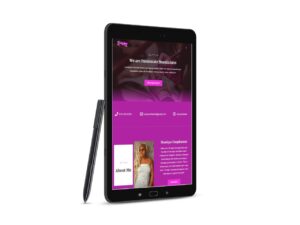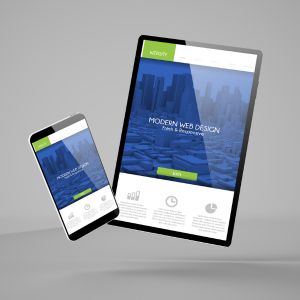In today’s world, a website is usually the very first thing customers see when they interact with a brand. That’s why it’s super important for businesses to pay attention to their website design and how it affects their brand identity. In this article, we’ll dive into just how much website design can impact a brand. And we will also share some tips on how you can use this knowledge to your advantage as a business.
What is Brand Identity and Website design?

Brand identity is the way a company presents itself to the world. It includes things like the company’s logo, colors, and messaging.

Website design is the process of creating a website that visually represents the brand identity and provides a user-friendly experience for visitors.
Think of brand identity as the personality of the company and website design as the outfit it wears to make a great first impression.
The Role of Website Design in Building Brand Identity
What is the Importance of website design in building brand identity?
Creating a professional and visually appealing website is important when it comes to leaving a lasting impression on potential customers. As pointed out earlier your website is often the first point of contact people have with your business. So, it’s important to make it count.
A well-designed website can help you establish trust and build credibility with your audience, while also letting you show off your unique brand personality. Plus, it’s a great way to stand out from the crowd and set yourself apart from competitors.
By investing in a top-notch website, you’ll be able to communicate your brand’s values and create a strong online presence that attracts and keeps customers coming back for more. Let’s look at 4 ways website design can be used to build brand identity.

The Role of Website Design in Building Brand Identity
1. Consistency in Design
Having a consistent look across your website and brand identity is super important! This helps people recognize and remember your brand, builds trust, and makes your business look more professional. Plus, when everything looks uniform, it’s easier for customers to understand and remember what you’re all about.
Here are a few tips to help you create a consistent look for your brand:
- Create a brand style guide as a reference for anyone creating content for your brand.
- Use consistent visual elements across all platforms and channels, including your logo, fonts, and color scheme.
- Create templates for your content to ensure a consistent look and feel.
- Regularly review and update your visual elements to keep your brand fresh and relevant.
Follow these guidelines to create a strong visual identity for your brand. Doing so will help build credibility with your audience and drive your business forward.
Examples of successful brand identity and website design consistency
A few examples of companies that have successfully maintained a consistent brand identity and website design are:
- Apple, a well-known technology company, is recognized for its sleek and minimalistic design approach, which is consistently reflected throughout its products, website, and branding.
- Coca-Cola, a beloved soda brand, has maintained its iconic red and white color scheme and distinctive logo design for over a century, which is evident on its website and other marketing materials.
- Nike, a prominent sportswear brand, has an instantly recognizable and dynamic “swoosh” logo that is consistently used across its website and other branding efforts.
2. User Experience
Having a well-designed website is critical in shaping a user’s perception of a brand. A visually appealing and easy-to-use website can boost engagement, conversions, and overall user experience by creating positive emotions. Such as trust and credibility to name a few.


On the other hand, a cluttered website with slow loading times and confusing navigation has a negative impact on a user’s perception of a brand. Therefore, brands must prioritize website design as a crucial element in creating a positive user experience and perception.
In today’s world where mobile devices are found everywhere, it’s crucial for websites to be mobile-responsive and user-friendly. This ensures that visitors can easily access and navigate your site no matter the device they use. Ultimately leading to a better experience for them.

Additionally, placing clear/prominent call-to-actions helps guide users towards desired actions such as making a purchase or contacting your business. This can result in improved conversions and an enhanced user experience.
Designing websites with these elements in mind improves user experience, brand perception, and conversions.
How Important is a User-friendly and visually appealing website design
A user-friendly and visually appealing website design is important. Because it enhances the user’s experience and engagement with your website. It can also help to increase the amount of time visitors spend on your site, reduce bounce rates, and ultimately lead to more conversions.
A well-designed website enhances your brand’s credibility and professionalism making it easier for users to find the information they need.
Apart from the advantages above, there are various reasons why an attractive website is vital for your online presence’s success. Here are some additional factors to keep in mind:
- Easier Navigation: Clear and intuitive navigation menus, search bars, and organized content. Makes it easier for visitors to navigate your site which reduces frustration and increases engagement.
- Memorable First Impression: A visually appealing website can capture your audience’s attention and create a memorable first impression. Through the effective use of color schemes, typography, and imagery.
- Positive Emotional Response: A website that is easy to use and visually attractive creates a positive emotional response in your audience. And also builds trust and loyalty leading to increased conversion rates and sales.
By investing in quality design and user experience, you can create a website that not only looks great but also drives meaningful engagement with your audience.

The Role of Website Design in Building Brand Identity
3. Brand Messaging
Your website’s design can be a powerful tool in communicating your brand’s message and values to your intended audience. Every aspect of your website, including colors, fonts, layout, and images, can be used to build a harmonious brand image and convey your brand’s personality.
For instance, if your brand is centered around sustainability, you might incorporate earthy colors and natural imagery in your website design to reflect this value. Conversely, if your brand focuses on luxury, you might utilize sleek, modern design elements and high-quality images to create an exclusive and upscale vibe.

By thoughtfully considering your website’s design, you can ensure that your brand messaging and values are communicated clearly and effectively, allowing you to connect with your target audience and cultivate a robust and recognizable brand identity.
Examples of effective brand messaging through website design
Here are two examples of how to effectively communicate your brand messaging through website design:
Consistency is key. Use brand colors, fonts, and imagery throughout your website to reinforce your brand’s identity and make it more memorable to visitors. For instance, if your brand has a lively and playful personality, incorporating bright, bold colors and playful imagery throughout your website can help convey this vibe.
Speak directly to your target audience. Use clear and concise messaging that resonates with your ideal customer and highlights your unique selling points. This builds trust with visitors and encourages them to further engage with your brand. For example, if you are targeting millennials, it’s best to use language that will attract and resonate well with them.
4. Differentiation in a Crowded Market
In a crowded market, it’s crucial for businesses to differentiate themselves from competitors. Establishing a unique identity, showcasing strengths, and attracting customers are essential for building brand recognition and loyalty. By doing so, businesses are more likely to succeed and thrive in a competitive environment.

Website design plays a vital role in establishing your brand’s identity and distinguishing it from others in the market. With a well-crafted design, your brand can come across as professional, trustworthy, and engaging to potential customers.
Moreover, it’s an excellent way to convey your brand’s unique values and personality to the audience, setting you apart from the competition. By incorporating a distinctive color scheme, fonts, and imagery, your website can leave a lasting impression, cementing your brand in the minds of your audience.
Conclusion
The design of a website is a fundamental aspect of brand identity. A well-crafted website can communicate a brand’s personality, and values while creating a memorable user experience. When you use elements such as color, typography, and visual imagery, you can effectively convey your message and differentiate yourself from competitors. That’s why investing in good website design can ultimately strengthen your brand’s identity and increase recognition. let us help you create a website that truly reflects your brand, Contact us.




